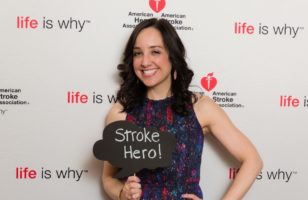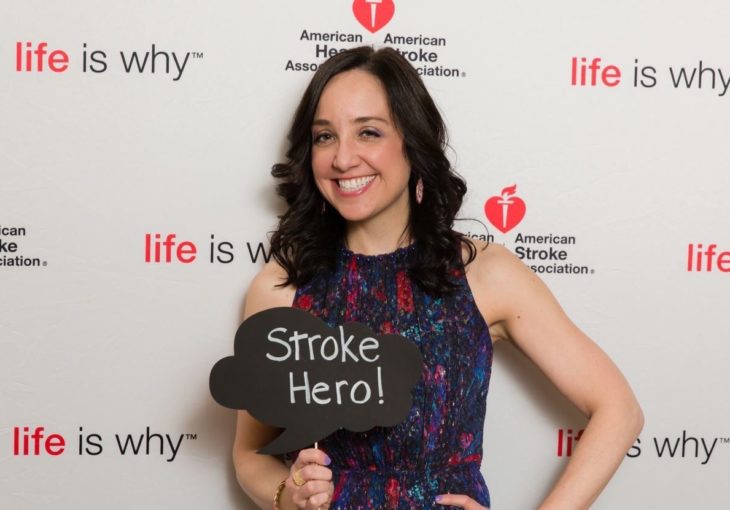 By Stacy Quinn, Guest Blogger, Go Red for Women Survivor Ambassador and Member of the Northern NJ American Heart Association Board of Directors
By Stacy Quinn, Guest Blogger, Go Red for Women Survivor Ambassador and Member of the Northern NJ American Heart Association Board of Directors
The global pandemic has thrown everyone into situations that no one could have ever expected or prepared for. It’s also upended the U.S. health system, which is grappling with nearly 1.55 million cases of COVID-19 as of May 21. Not only is the abundance of COVID-19 cases an unprecedented health care burden, the ubiquitous awareness of the disease has people scared to go to the hospital when they’re experiencing health emergencies.
This is a natural fear, but it’s one that we need to overcome. Our health is too important to chance, and we can’t let fear stop us from getting help. As a stroke survivor, I waited 10 days before getting help—and that wasn’t because of the global pandemic. It was purely because I thought the symptoms I was experiencing were caused by stress and trying to do too much. In thinking back, I have no doubt that had there been a global pandemic at the time, I might have waited even longer. And if I had, there’d be an even higher likelihood that my actions—or inactions in this case—could have cost me my life.
It’s been five years now, but I remember it like it was last week. Back then, I worked in Manhattan. That day I got off the subway in midtown just like any other morning, but I asked for a shot of espresso in my coffee to help combat what was growing into the “worst headache of my life.”
I had a busy day ahead of me, and I wasn’t going to be derailed by a headache. My to-do list was longer than normal and I had an important meeting with my new boss mid-morning. I’ve never been a quitter, and I was determined to charge through the pain, but I was struggling. My head was pounding, my stomach was upset and my vision had become a little blurry. But I trudged onward.
Then came the meeting with my boss. I needed to update her on some projects, and as I went down the list, I lost my speech. Instead of words and phrases, my speech had changed to garbled babble.
Hearing myself was the real “uh oh” moment, except I wouldn’t use the phrase “uh-oh.” So I paused, took a deep breath and started speaking again. More unintelligible garble. I stopped again, closed my eyes and took another deep breath. It was the first time since being a young girl that I couldn’t form words, let alone a coherent sentence. A few seconds later, my speech returned to normal.
It was a surreal experience, and I was unprepared for it. I didn’t know how to process it, yet I wrote it off as a side effect of stress and a bad headache. So what did I do? I got back to work and charged through the headache—and the rest of the day.
 That headache, however, didn’t go away. It stuck with me for another 10 days. That’s when I finally got help. At the suggestion of a very cautious neurologist, I agreed to an MRI. It turns out that the headache and slurred speech were the result of a transient ischemic attack (TIA), also known as a mini-stroke.
That headache, however, didn’t go away. It stuck with me for another 10 days. That’s when I finally got help. At the suggestion of a very cautious neurologist, I agreed to an MRI. It turns out that the headache and slurred speech were the result of a transient ischemic attack (TIA), also known as a mini-stroke.
So here’s the science behind my TIA. We all have critical blood vessels in our necks that deliver blood to our brain. One on the left and one on the right. For me, the interior walls of my left carotid artery essentially collapsed, causing a 90% blockage of blood flow to my brain. That’s what caused the slurred speech and headache, and at that point I should have immediately gone to the hospital instead of trying to finish my meeting.
Thinking about how my experience unfolded in the context of what we’re all going through now gives me great pause. I know myself, and back then, I had no idea how much risk I put myself in. I’m a young woman who eats right, exercises and keeps close watch of my cholesterol and blood pressure. So amid a global pandemic, where all news is focused on an unprecedented health crisis with ever-widening implications, I’m not sure I would have sought medical help. I might have been just like the thousands of Americans who are fueling what doctors are referring to as a sub-epidemic of people who need hospital care but don’t dare get help.
For example, the call volume at one major stroke center dropped from about 550 calls per month about possible stroke patients to about 100 in the first half of April. This is disheartening. Stroke is a medical emergency and doesn’t discriminate. It can happen to anyone at any time. According to the American Stroke Association, someone—women, men, young people and babies—in the U.S. has a stroke every 40 seconds. Research also indicates that stroke is becoming increasingly more common in younger people and women.
 The good news is that 80% of strokes are treatable and preventable. But that stat only holds true if people take care of themselves and get help when they need it. So the bad news is that doctors across the country acknowledge that the decline in calls and patients seeking emergency care will likely translate into higher rates because people are scared to get help.
The good news is that 80% of strokes are treatable and preventable. But that stat only holds true if people take care of themselves and get help when they need it. So the bad news is that doctors across the country acknowledge that the decline in calls and patients seeking emergency care will likely translate into higher rates because people are scared to get help.
Hospitals and health care organizations are stepping up their efforts to educate the public about the safety of health facilities and care. While they continue those efforts, it’s important that we all know what stroke looks like and how to respond when they see it. The American Stroke Association estimates that 1 out 10 Americans don’t know the symptoms of stroke.
Too many people, including me, seek help long after they believe they’ve had a stroke. This mistake increases the odds of serious complications or death. Every second counts with stroke. Nearly 2 million brain cells die each minute a stroke remains untreated. If you get help immediately, doctors can help in a variety of ways, including administering clot-busting medications and stent retrievers.
Knowing the symptoms of stroke isn’t complicated. In fact, there’s is an easy way to remember the most common symptoms of stroke. It’s called FAST. If you experience any one of these symptoms – facial drooping, weakness or problems in an arm, slurred speech or have difficulty speaking – don’t waste any time, call 9-1-1. Also, if you ever have the “worst headache of your life” you should seek medical attention immediately.
There has never been a time in our lives like what we’re going through now. But even with so much uncertainty everywhere, we need to keep ourselves healthy and safe.
To learn more about preventing, treating and beating stroke, visit www.stroke.org.
The views, opinions and positions expressed within these guest posts are those of the author alone and do not represent those of The American Heart Association | American Stroke Association. The accuracy, completeness and validity of any statements made within this article are not guaranteed. We accept no liability for any errors, omissions or representations. The copyright of this content belongs to the author and any liability with regards to infringement of intellectual property rights remains with them.
The American Heart Association’s blog is not intended to provide medical advice or treatment. Only your healthcare provider can provide that. The American Heart Association recommends that you consult your healthcare provider regarding your personal health matters. If you think you are having a heart attack, stroke or another emergency, please call 911 immediately.
